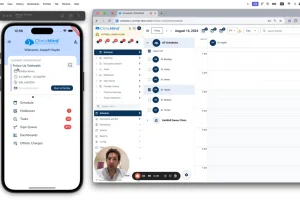AI has revolutionized many different industries, and healthcare is no exception. In recent years, medical billing has benefited greatly from using Artificial Intelligence.
Where are the major pain points in healthcare today?
1-Patients:
A major challenge today is long wait times. In 2022, the average wait time for a physician appointment in the 15 largest U.S. metro markets is 26 days [1]. The longer someone has to wait, the higher the risk of complications or possibly more serious health issues arising.
Some possible solutions to address this problem include
- use of telemedicine involves providing medical consultations and services remotely using technology such as video conferencing.
- increasing the number of healthcare professionals in practice,
- streamlining administrative processes and
- improving patient communication and education to help prevent avoidable illnesses and hospital visits.
2-Physicians:
Physician burnout is affecting a high percentage of physicians. 62.8% of physicians experienced at least one symptom of burnout in 2021 [2]. Reasons for burnout include outdated technology and inefficient workflows, which contribute to increased work stress and frustration even for skilled and experienced professionals. Additionally, a shortage of skilled workers puts extra pressure on those in the workforce, leading to burnout and poor job satisfaction.
One potential way to address these challenges is to invest in updating technology and improving workflows, which can streamline processes and reduce workload. Additionally, increasing access to training and education for both current and future workers could help alleviate the skill shortage issue. It’s essential to take proactive steps to address these issues to ensure that our healthcare workforce can continue to provide top-quality care to patients without experiencing burnout.
3-Payers:
Payers recognize the importance of delivering better experiences to their customers. To meet these expectations, payers are focusing on several critical areas:
A-Improving ease of use
Improving ease of use can be achieved through various initiatives, such as clear communication to help customers understand their network, status updates on claims, and easy-to-use portals and tools.
B-Ensuring the availability of services on-demand.
Having around-the-clock access to support and information is essential to ensuring customers can get the help they need when they need it.
To support these initiatives, payers need to leverage data-driven insights to create value for their customers. This can be achieved through technologies such as artificial intelligence and machine learning, which can help to identify trends and patterns in customer behavior and preferences, enabling payers to provide targeted and personalized support proactively. Overall, payers must continue to innovate and adapt to meet the evolving needs and expectations of their customers, and taking a data-driven approach to improve ease of use and availability on demand could be a critical step forward.
C-Reducing hospital readmission rates
Payers are leveraging machine learning to gain actionable insights from healthcare data sets. By analyzing claims data, payers can identify trends in patient outcomes and determine the most effective treatments for specific patient populations. They can also predict which patients are at a higher risk of complications or readmissions, e.g., inflammation and blood clotting occurs most following surgery, and provide this information to providers to help them take preventative measures. This kind of data-driven approach is valuable because it enables healthcare providers to deliver more personalized care to patients, leading to improved patient outcomes and reduced costs. By sharing these insights, payers can demonstrate the value of their contributions to patient care while simultaneously empowering providers to make better decisions and improve healthcare delivery.
Improved Medical Coding Accuracy
One way AI has been used in medical billing is through automated billing and coding. The technology can analyze electronic health records and notes made by healthcare providers and use that information to generate codes that accurately bill for specific services. This reduces the risk of errors, which can result in denied claims and lost revenue.
Improved Insurance Cash Flow Prediction and Denial Management
AI is also used for claims prediction. By analyzing past claims data, AI identifies patterns and predicts which claims will likely be denied. This allows billing teams to proactively address issues and avoid denials, which saves time and money. Also, when denials are increasing due to a lack of medical necessity, lacking documentation, or coding mistakes, AI can analyze the denials to find the cause and then create tasks within the EHR to correct the likely causes for denials.
Improved Medical Billing Workflow
To automate the claims follow-up process, AI analyzes claims data and identifies the claims that are most likely to require follow-up. AI automatically generates follow-up tasks for billing teams. This reduces the administrative burden on billing teams and ensures that claims are followed up on in a timely manner.
The deep learning of users’ interaction with EHR and billing software allows the learning of users’ habits, needs anticipation, and the display of the right data at the right time. Automatically retrieving and displaying all of the required data and just at the right time drastically reduces the amount of labor spent on manual billing tasks and allows staff to make better decisions about the next steps for denial resolution.
Improved and Expedited Pre-Authorizations
The current pre-authorization process can be a real headache for patients and healthcare providers. A streamlined, automated system that can quickly analyze a patient’s health data and determine the medical necessity of a procedure would be a game changer. Imagine how much time, stress, and resources could be saved if medical billers no longer had to worry about pre-authorization denials or chasing down authorization numbers. It’s exciting to think about how technology can continue to improve and simplify healthcare processes like this.
Improved patient customer service
With the rise of technology, we’re seeing a lot of improvements in healthcare that can benefit patients and providers alike.
Using bots for patient interactions like appointment scheduling and payment collection is one way to streamline processes and reduce frustration for patients and billing staff. By standardizing these tasks, there’s less room for error and confusion, leading to smoother, more efficient interactions, significantly reducing the incidence of difficult patient interactions about billing and potentially improving the relationship patients have with billing staff.
Additionally, with more streamlined billing procedures, patients may feel more confident and comfortable when interacting with billing staff, which could improve the overall patient experience.
Fraud Detection and Prevention
In addition to streamlining the medical billing process, AI can help prevent fraud. By analyzing claims data, AI can detect fraudulent activity patterns, such as billing for services that were not provided. This helps prevent healthcare providers from losing revenue to fraudulent claims and helps ensure that patients receive the care and services they need.
Overall, AI has the potential to greatly improve the efficiency and accuracy of medical billing. By automating time-consuming tasks, predicting denials, automating claims follow-up, and detecting fraud, AI can help healthcare providers save time and money and ensure patients receive the care they need.
References
- Sara Heath, Average Patient Appointment Wait Time Is 26 Days in 2022, Patient Engagement HIT
- Shanafelt et al., Changes in Burnout and Satisfaction With Work-Life Integration in Physicians During the First 2 Years of the COVID-19 Pandemic, Mayo Clinic Proceedings, VOLUME 97, ISSUE 12, P2248-2258, DECEMBER 2022
- What Is Deep Learning and How Will It Change Healthcare? Health IT Analytics, November 30, 2018
- Thomas Davenport, and Ravi Kalakota, The potential for artificial intelligence in healthcare, Future Healthc J. 2019 Jun; 6(2): 94–98.
- Dolores Derrington, Artificial Intelligence for Health and Health Care, December 2017 JSR-17-Task-002, The MITRE Corporation
- 2020 Estimated Improper Payment Rates for Centers for Medicare & Medicaid Services (CMS) Programs
A Future Book Publication Note:
This article is a chapter in the forthcoming 2nd Edition book “Medical Billing Networks and Processes,” authored by Dr. Yuval Lirov and planned for publication in 2024. We will post more chapters on this blog soon.










